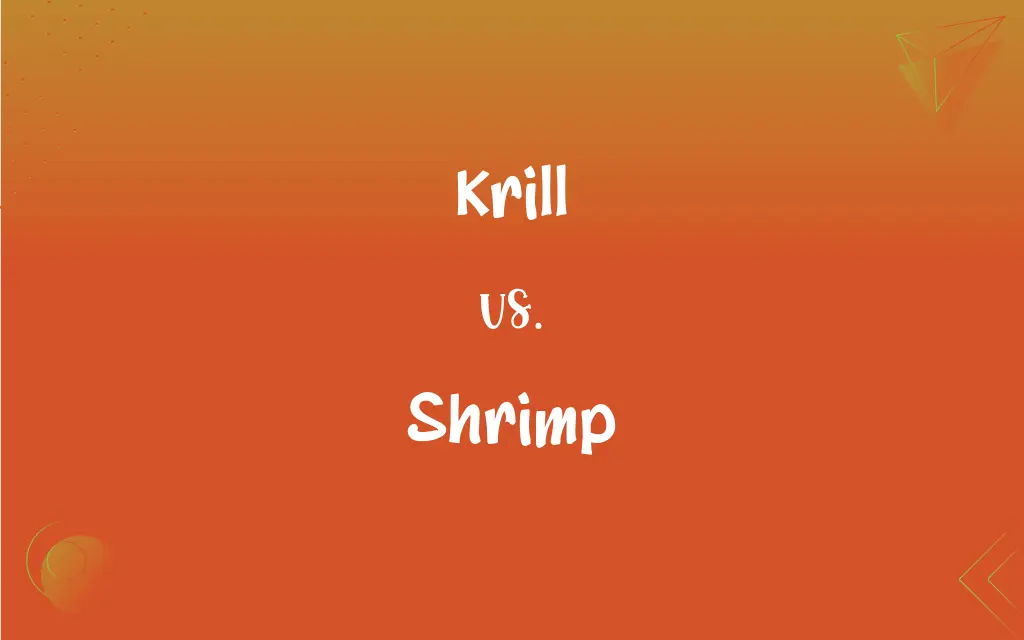Krill vs. Shrimp: What's the Difference?
Edited by Janet White || By Harlon Moss || Updated on August 19, 2024
Krill are small, cold-water, planktonic crustaceans, while shrimp are larger, diverse, and primarily benthic; both are invertebrates and important in aquatic food chains.

Key Differences
Krill, small crustaceans, are primarily found in cold ocean waters and are known for their massive swarms, which are a crucial food source for larger marine animals. Shrimp, on the other hand, are more diverse in size and species, found worldwide, and are popular in human cuisine.
In terms of physical structure, krill have bodies that are more transparent and are not usually larger than 6 cm, whereas shrimp exhibit more variety in coloration and can grow significantly larger, with some species reaching up to 20 cm in length.
Krill primarily feed on phytoplankton, making them a key component in the ocean's carbon cycle by consuming carbon-rich food sources. Shrimp have a more varied diet, consisting of plankton, small fish, and detritus, depending on their species and habitat.
Ecologically, krill are fundamental in Antarctic food webs, with their swarms supporting large marine mammals like whales. In contrast, shrimp contribute to their ecosystems in different ways, often as both predators and prey, and are a key species in both freshwater and marine environments.
Economically, krill are harvested mainly for aquaculture feed, fish bait, and human dietary supplements due to their omega-3 fatty acids. Shrimp are more directly linked to human consumption, forming a significant part of the global seafood market.
ADVERTISEMENT
Comparison Chart
Size & Appearance
Small, transparent bodies, up to 6 cm
Larger, varied colors, up to 20 cm
Habitat
Cold ocean waters, often Antarctic
Worldwide, diverse habitats
Diet
Primarily phytoplankton
Varied: plankton, small fish, detritus
Role in Ecosystem
Crucial in Antarctic food webs
Important in various marine food chains
Economic Value
Aquaculture feed, dietary supplements
Significant in the global seafood market
ADVERTISEMENT
Krill and Shrimp Definitions
Krill
Known for swarming behavior and forming large, dense groups.
The ocean surface was pinkish, teeming with millions of krill.
Shrimp
Known for their diversified species, found in various habitats.
Marine biologists discovered a new shrimp species in the coral reef.
Krill
Small crustaceans predominantly found in cold ocean waters.
The whale devoured the school of krill with a single gulp.
Shrimp
Omnivores, they feed on plankton, small fish, and detritus.
The shrimp scoured the ocean floor for bits of organic matter.
Krill
Harvested for their omega-3 fatty acids and used in supplements.
The label shows that this supplement is rich in krill oil.
Shrimp
Important in food chains, serving as both predators and prey.
In the marsh ecosystem, shrimp are vital prey for many fish species.
Krill
Essential in the carbon cycle due to their consumption of phytoplankton.
By feeding on phytoplankton, krill play a significant role in the ocean's carbon cycle.
Shrimp
Small to medium-sized crustaceans, often used as seafood.
She added the shrimp to the skewers just before grilling.
Krill
A primary food source for larger marine animals like whales.
Krill form a substantial part of the blue whale's diet.
Shrimp
Economically valuable, forming a significant seafood industry.
The coastal town's economy thrived due to its booming shrimp industry.
Krill
The collection of small marine crustaceans of the order Euphausiacea that are the principal food of baleen whales.
Shrimp
Any of various small, chiefly marine, often edible decapod crustaceans that have a laterally compressed, elongated body with long antennae and long legs used for swimming. The shrimps include species belonging to the superfamily Penaeoidea of the suborder Dendrobranchiata and to the infraorder Caridea of the suborder Pleocyemata.
Krill
Any of several small marine crustacean species of plankton in the order Euphausiacea in the class Malacostraca.
Krill
Shrimp-like planktonic crustaceans; major source of food for e.g. baleen whales
FAQs
What do krill eat?
Krill primarily consume phytoplankton.
Are shrimp and krill the same?
No, shrimp are generally larger, have diverse species, and live in varied habitats, while krill are smaller and predominantly cold-water creatures.
Can humans eat krill?
Krill are more commonly processed into supplements and feed, but are edible.
What are krill?
Krill are small, cold-water crustaceans known for swarming behavior.
How are shrimp consumed by humans?
Shrimp are a popular seafood, eaten in various dishes worldwide.
Are krill populations at risk?
Some krill populations face threats from climate change and overharvesting.
What do shrimp eat?
Shrimp have varied diets, including plankton, small fish, and detritus.
How big do krill get?
Krill typically grow up to 6 cm in length.
Where are shrimp found?
Shrimp inhabit diverse environments, from freshwater to various marine habitats.
Can shrimp be farmed?
Yes, shrimp aquaculture is a significant industry worldwide.
Do krill have any commercial value?
Yes, they're harvested for aquaculture feed, bait, and dietary supplements.
What's the importance of krill in the ecosystem?
Krill are a primary food source for many marine animals and crucial in carbon cycling.
Are shrimp healthy to eat?
Shrimp are high in protein and nutrients, but should be eaten in moderation due to cholesterol.
Are shrimp important to their ecosystems?
Yes, shrimp serve as both predators and prey, crucial in aquatic food chains.
Are there different species of shrimp?
Yes, there are numerous shrimp species, each with unique characteristics.
Why are krill swarms important?
Krill swarms support large marine predators, especially in Antarctic waters.
How do shrimp contribute to the economy?
They're a major part of the seafood industry, important for local and global economies.
What is the largest species of shrimp?
The giant tiger prawn can grow up to 33 cm in length.
How do krill affect carbon cycling?
By consuming carbon-rich phytoplankton, they're integral to the ocean's carbon cycle.
What are shrimp?
Shrimp are diverse, larger crustaceans found globally in various water habitats.
About Author
Written by
Harlon MossHarlon is a seasoned quality moderator and accomplished content writer for Difference Wiki. An alumnus of the prestigious University of California, he earned his degree in Computer Science. Leveraging his academic background, Harlon brings a meticulous and informed perspective to his work, ensuring content accuracy and excellence.
Edited by
Janet WhiteJanet White has been an esteemed writer and blogger for Difference Wiki. Holding a Master's degree in Science and Medical Journalism from the prestigious Boston University, she has consistently demonstrated her expertise and passion for her field. When she's not immersed in her work, Janet relishes her time exercising, delving into a good book, and cherishing moments with friends and family.































































